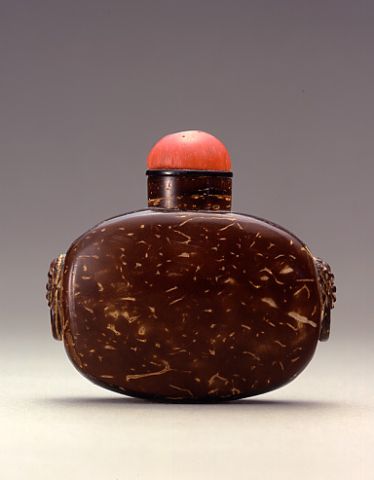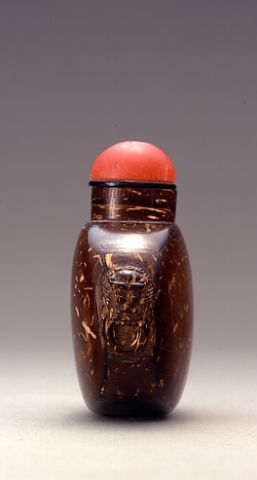

Bottle ID: 506
WITH RING HANDLES
Date: 1780-1880
Height: 65 mm
Coconut-shell, of flattened, ovoid form with a cylindrical neck, and recessed, rectangular foot, made up of separate pieces, the main sides with convex panels, the neck carved from one thick piece of shell, the narrow sides and shoulders as flat panels carved with mask and ring handles.
Similar Examples:
Crane Collection no. 380.
Lawrence, Clare. The Alexander Brody Collection of Chinese Snuff Bottles, 1995, p. 41, no. 57.
Moss, Hugh, Victor Graham and Ka Bo Tsang. A Treasury of Chinese Snuff Bottles - The Mary and George Bloch Collection, 2009, Vol. 7, Part 1, pp. 58-59, no. 1486.
Provenance:
Hugh Moss (HK) Ltd.
Coconut-shell snuff bottles became particularly popular during the second half of the Qing dynasty, especially among the literati, who as seal carvers were also skilled with the iron-brush. The carver, who appreciated the natural surface, added their own designs of landscapes, ancient bronze-script inscriptions, old coins and poetic responses, often added their names and sometimes the date. Their popularity among the literati may have created a wider demand for coconut shell snuff bottles in general, as many have no added designs or inscriptions. The simplest way of making a coconut-shell snuff bottle was to take two convex segments from the shell and pin and glue them together at the edges and most ‘literati inscribed’ bottles are of this basic construction. A more complex method was to add a further piece in the shoulders, and add a standard neck. Occasionally, however, even more complex segmented forms were made where the final shape owed little to the dictates of the material. This is an unusual version of a complex form, complete with the ubiquitous mask handles of the snuff bottle world.
< Back to full list
 English
English 中文
中文